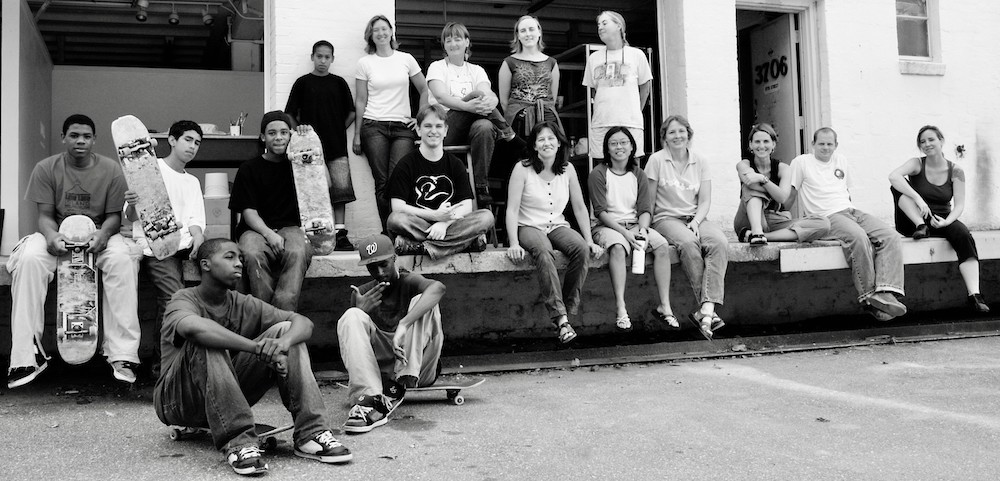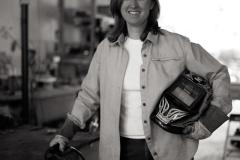Red Dirt Studio


Red Dirt 2018
Every fall, in preparation for Red Dirt's Open Studio, I attempt to write a short blurb for the postcard, and every year it's hard. We are, at the moment, two artists-in-residence, twelve seminar members, an intern, and me - in this warehouse, in this emerging artist community, in this industrial suburb of Washington, D.C. Everyone is an artist, each at a different stage of professional development. They are here to get critical feedback, to be more professional in their practice, to share resources and opportunities, and to engage with others who are drawn to a less traditional approach to clay. Most seminar participants have day jobs, too- psychotherapist, ceramics teacher, art education teacher, bartender, real estate agent, community affairs analyst, and technical information specialist, among others. All bring their different perspectives and resources, and all are here to shake up their art practice in some way. What I love about this place is what makes is hard to define. On any given day, the studio looks like a variety of different enterprises. Some days it looks like art graduate school, some days like a nonprofit craft center for neighborhood kids.
I love teaching; I consider it part of my creative work. But after ten years in a less-than-satisfying position as adjunct professor at a local art school, I needed to do it differently. So in the fall of 2002, I started Red Dirt Seminar; I imagined part-graduate school, part-business-of-art incubator. I wanted time and space for ideas to evolve. I wanted everyone to have enough room to spread out, to leave work up and ongoing. Having sufficient private studio space as well as common space was critical. I wanted to see not only the conscious questions in the work people were making, but also the less conscious (or less self-conscious) questions and musings exhibited by the ambient information in their studios.
As a model for Red Dirt's gallery/critique space, I used the Rhodes Room from my graduate experience at Alfred. This was an empty room, maybe 20ft x 20ft, and site of some of the most interesting work to happen at Alfred. You could reserve the Rhodes Room to see your work in an uncluttered space, host your critique, do a performance, or just have a quiet spot to write, think, or sleep. Often it was an opportunity to step outside your usual thinking or current body of work. At Red Dirt we also use our gallery/critique space for hosting workshops and exhibitions by visiting artists. The gallery provides a great opportunity to have new people and new work come in to the studio.
Red Dirt gives me the freedom to teach clay as it exists under the larger umbrella of sculpture. Clay gets to be more vocal as clay when it's in the presence of other materials. My college ceramics teacher, Gary Wagoner, asked me twenty years ago, "Why are you making this out of clay?" I realized he expected a more thoughtful answer than "Because I'm in a ceramics class." This opened up the idea that materials are carriers of information and bring content to the work before one ever touches them. Sometimes clay is exactly what you want; sometimes other materials do the job better.
What I really wanted for myself from this new teaching model was that it be organic to my studio work. At Red Dirt, I use my studio as a teaching resource. Whether I'm building a crate, photographing work, or struggling to resolve aesthetic issues, I can share my current inquiry and learning just by inviting the seminar group into my studio.
Similarly, the structure of the seminar is fluid, based on whatever issues people are running into with their own work. Tetyana's work provides an opportunity to learn about making hoists to work with large plaster molds. Jenna's questions are more about performance and documentation than the object, at times offering seminar members a chance to participate. Judit's rich surface and texture, Beth's reduction to essence, Joe's crystalline glazes, Leila's abstracted narrative, Sandy's material translations, Kyan's installations, Liz's poetic objects: the opportunities for learning are astounding.
With so many people working at Red Dirt, we have a steady stream of interesting visitors: collectors, gallery owners, designers, architects, artists, and random passersby. As they tour the studios, you can see the opportunities and connections blossom. The physical setup of adjoining warehouse bays is ideal, with the seminar on one side and my studio on the other. We have both privacy and access.
Visiting artists bring other voices and fresh insights. Red Dirt hosts master ceramic artists brought to town by the Renwick Gallery and our graduate school friends. Novie Trump, director of Lee Arts Center and an established ceramic artist, is setting up her own studio nearby. We're already scheming up collaborations between the two studios.
The Open Studio is our big event of the year, our thesis show. The preparation and public nature of it both stress everyone out and energize us. Studios get cleaned up, lit, and presented with an awareness of the external gaze that will soon he upon us. Work that has been talked about, attempted, and left in some middle ground of resolution suddenly comes into being. And after the big event, we have a few weeks of discussion and critique as we slow down to really look at our own work.
We're good at sharing, but we're good at competition, too. Somebody gets into a show; somebody gets some press: that can be a good, motivating kick in the pants for the rest of us.
A much less structured, but equally rewarding part of the teaching and learning at Red Dirt involves the neighborhood kids. We are located in a mixed-use industrial/residential community where kids are seriously underserved in their after-school activities. With the garage doors open on beautiful afternoons, Red Dirt is as big a kid magnet as the ice cream truck. Kids borrow shovels to dig clay and then make art on the loading dock. Joe takes a break from throwing pots to help tighten up some handlebars, while I look for a scrap of plywood that might serve as a skateboard ramp. The kids have really adopted us into their neighborhood. It's funny: they can't really comprehend that what we're doing is work, because it looks like so much fun. In their minds, we're just big kids. That's a good perspective to remember when stressed out over a show deadline.
The kids are pretty respectful. They come into the studio and actually look at what we're making. I explain what I'm doing, and they offer amazingly astute associations and suggestions. Usually, they like the work. Occasionally, they'll tell me that they don't really think it's working. Sometimes I won- der what they take away from all that. Will they consider becoming artists because they grew up around people who made their livings that way? I wish I had had that opportunity as a kid; I was in college before I came across that role model.
In recent years, the kids have started skate- boarding. They build ramps and jump over stuff in our studio parking lot, learning about sculptural issues in a hands-on way: weight, balance, force, trajectory, and gravity, not to mention tool use. They know the vise-grip pliers from the socket wrench. They know bearings need grease. They know how much three-quarter-inch plywood flexes over a six-foot span, and that you need at least three rows of bricks to support that ramp or it will fall when you skate over it.
This spring, the kids and I put together a proposal to build a real skate park in the defunct basketball court across from the studio. We pitched it to the Mt. Rainier city council and Maryland Parks and Planning, and the proposal was accepted. Most of the money is already in place; it's a matter of moving the project forward, coordinating among all the participants, and keeping the design intact. We celebrated our accomplishment, and now the kids want to know, how much longer will it take? Three weeks? They got a lesson in local government when we presented the proposal at their first city council meeting; now they are getting a les- son in state and local bureaucracy while we wait for things to happen. I am looking for- ward to the day when they get a lesson in turning their design into reality. Working with nonprofit design/builder East Coast Round Wall, the kids will help set up the structure, pack in the clay, mix and smooth the concrete, and then skate on their own work. The rest of Red Dirt is looking forward to that day, too. Several seminar members have volunteered to help build and to contribute artwork. I think Joe is even planning on doing some skating.
Open Studio is coming up. Ani Kasten, our new artist-in-residence, is preparing an exhibit of her work for the Red Dirt gallery. My new intern, Sean, is cleaning and organizing the studio, and at the same time making work for his first exhibit since his senior show. Kate Hardy, our longstanding artist-in- residence, is designing her concept for the front of the postcard, and I'm almost finished drafting
the text for the back. What I can condense is this: at its core, Red Dirt is about what can happen with the coming together of talented, smart, and curious people, all engaged in pushing themselves and each other to greater accomplishment in their work. It's about drawing on the resources of community, and at the same time giving back. Come by and check it out.

